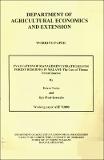| dc.contributor.author | Tsoka, Estere | |
| dc.contributor.author | Muir-Leresche, Kay | |
| dc.coverage.spatial | Malawi. | en |
| dc.date.accessioned | 2015-12-01T11:24:35Z | |
| dc.date.available | 2015-12-01T11:24:35Z | |
| dc.date.issued | 2000-03 | |
| dc.identifier.citation | Tsoka, E. and Muir-Leresche, K. (2000) Evaluation of management strategies for forest reserves in Malawi: the case of Thuma Forest Reserve, AEE Working Paper No.7/2000. Mt. Pleasant, Harare: DAEE. | en |
| dc.identifier.uri | https://opendocs.ids.ac.uk/opendocs/handle/20.500.12413/7166 | |
| dc.description | An AEE Working Paper on forestry management and conservation at Malawi"s Thuma Forest Reserve. | en |
| dc.description.abstract | This paper demonstrates how functions and values of forest reserves can be used to determine appropriate management strategies of forest reserves. The paper also demonstrates how community perceptions and preferences can be incorporated in the decision making process. An investigation is also carried out on the social and economic factors that can determine community self interest and willingness to get involved in forest management activities. A simple framework for analysing forest reserve management strategies has been developed using Multicriteria Analysis.
Results from the analysis suggest that communities surrounding Thuma Forest Reserve (TFR) seem to perceive the benefits from the forest reserve to be less that those from the alternative use of the land (cultivation). It also appears that local leaders are perceived to be weak in enforcing regulations and therefore not to be effective in protecting the forest reserve. The state is perceived to be the best management option for future preservation but not for direct benefits to the community. Participatory management with both the communities and the state involved is. on the other hand, perceived to be the option that can encourage future preservation and increase direct benefits to the neighbouring community. Another finding of the study is that willingness to participate in forest management activities appears to be affected by literacy level, income level and land holding size.
The analysis of the management options has indicated that participatory management can best maintain the water catchment role of TFR, which is very crucial to the residents of Lilongwe City. Further research should consider ways in which those benefiting from it could reward those protecting the catchment in order to ensure continued catchment protection . | en |
| dc.language.iso | en | en |
| dc.publisher | Department Of Agricultural Economics and Extension (DAEE) (University of Zimbabwe) (UZ) | en |
| dc.relation.ispartofseries | Agricultural Economics & Extention (AEE); Working Paper No.7/2000. | |
| dc.rights.uri | http://creativecommons.org/licenses/by-nc-nd/4.0/ | en |
| dc.subject | Environment | en |
| dc.subject | Rural Development | en |
| dc.title | Evaluation of management strategies for forest reserves in Malawi: the case of Thuma Forest Reserve | en |
| dc.type | Series paper (non-IDS) | en |
| dc.rights.holder | University of Zimbabwe (UZ) | en |


